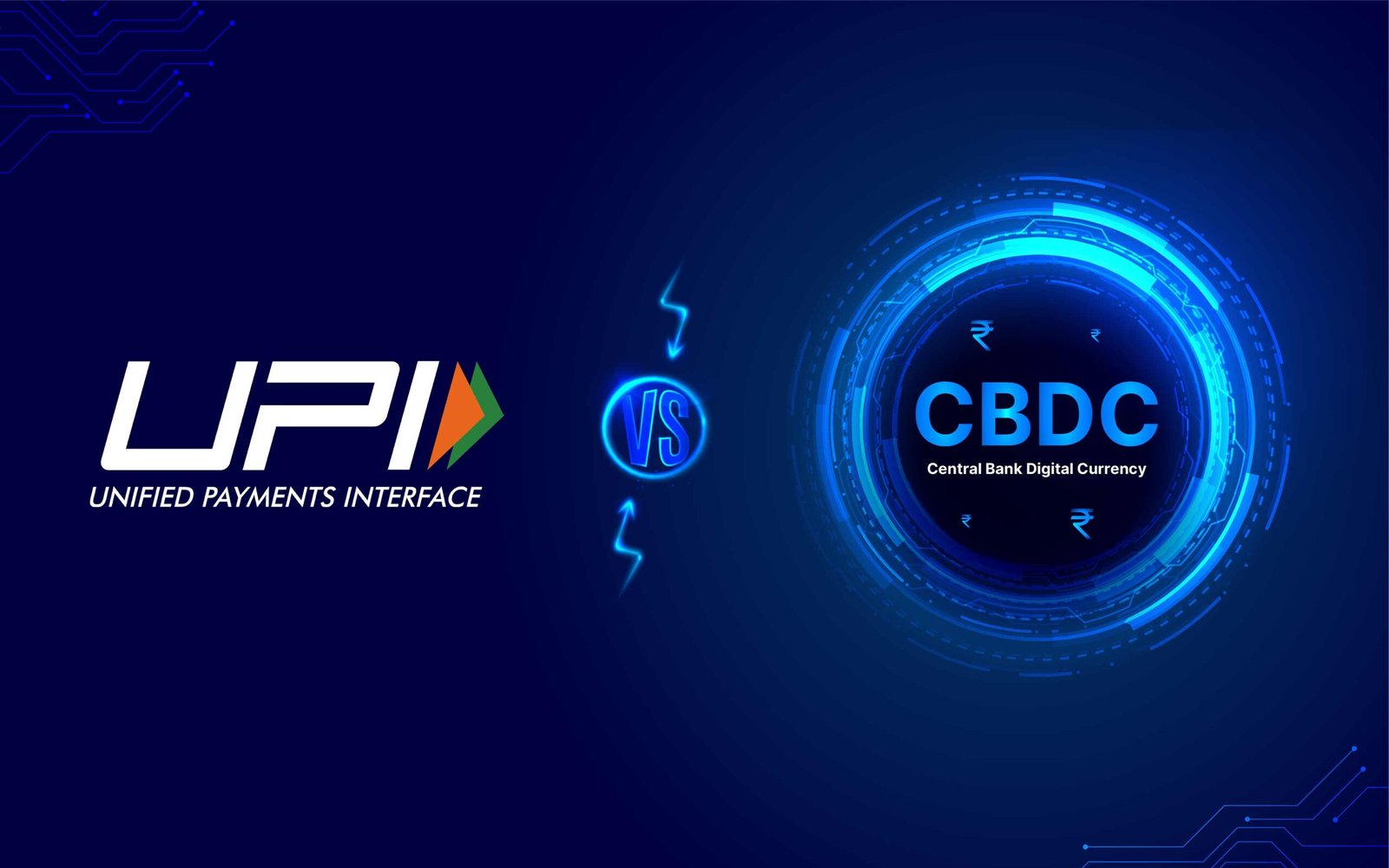-
Introduction: The Digital Rupee — India’s Bold Leap into the Future of Money
India is diving headfirst into the digital currency revolution with the launch of its own Central Bank Digital Currency (CBDC), popularly called the Digital Rupee. But what does this actually mean for you and me? Will it replace UPI, cash, or even the banking system as we know it? This blog dives deep into every layer of India’s CBDC initiative — from the technology powering it to the economic, social, and behavioral implications. Let’s break it all down.
-
What is the Digital Rupee (CBDC)?
🔸CBDC stands for Central Bank Digital Currency — it’s the RBI’s version of sovereign, digital money.
While cryptocurrencies like Bitcoin operate without a central authority, the Digital Rupee is completely controlled and issued by the Reserve Bank of India (RBI). Think of it like digital cash — it’s a legal tender but exists purely in a digital format. Unlike a wallet balance in Paytm or GPay, which is basically a digital version of your bank money, CBDC is direct liability on the RBI, meaning it’s as good as holding actual cash — just on your phone. This adds a layer of trust and stability missing from private digital assets or bank wallets.
-
Difference Between CBDC and UPI
🔸UPI is just a platform to transfer bank money. CBDC is the actual digital version of cash, not dependent on banks.
The biggest misconception people have is that CBDC = UPI. That’s just not true. UPI is like a high-speed train that moves your money from your bank to someone else’s bank. But the money itself still lives in your bank. On the other hand, CBDC is money itself, issued and backed directly by RBI — not by your bank. With UPI, if a bank server goes down, you’re stuck. With CBDC, you can still transact even in offline mode (more on that later). This makes the Digital Rupee a fundamentally new monetary infrastructure, not just a payment system.
-
Digital Rupee vs UPI: What’s the Real Difference?
| Feature | UPI | Digital Rupee |
|---|---|---|
| Intermediary | Yes (banks, apps) | No direct bank needed |
| Internet Needed | Yes | Can work offline (pilot) |
| Settlement Time | Near real-time | Instant |
| Transaction Type | Instruction-based | Token-based |
| Dependency | Bank accounts, apps | RBI-issued wallet |
| Anonymity | Linked to bank | Higher (can be anonymous) |
-
How Does the Digital Rupee Work?
🔸Digital Rupee works through two models: retail (for the public) and wholesale (for banks and institutions).
The retail CBDC (e₹-R) is the one you and I will use — to buy groceries, pay for tea, or transfer money to friends. It will be held in a digital wallet app (likely provided by banks or RBI-authorized platforms), just like you hold cash in your physical wallet. You won’t need a bank account to use it.
The wholesale CBDC (e₹-W) is for banks and financial institutions, allowing faster settlements in bond markets and interbank transactions. Both models are live in pilot mode across various cities in India.
-
Benefits of the Digital Rupee for Consumers
🔸Digital Rupee could bring lower transaction costs, instant settlement, and more privacy than UPI.
When you use UPI, your transaction goes through multiple intermediaries — your bank, NPCI, and the receiver’s bank — each incurring some cost and risk of delay. With the Digital Rupee, settlement is instant and final, like handing over a ₹100 note.
Also, UPI transactions are always tied to your bank account, exposing your spending history. CBDC wallets, especially if made anonymous like cash, could offer more privacy — a feature that’s almost lost in digital banking today. And since CBDC is issued by RBI, you won’t need to pay extra merchant charges or convenience fees.
-
Potential Risks and Concerns
🔸CBDC could disrupt banks, raise surveillance fears, and challenge existing fintech platforms.
While CBDC has potential, it’s not a risk-free party. If people start hoarding CBDCs in digital wallets (since they’re risk-free and RBI-backed), it could drain money from banks, threatening their lending capacity.
Then there’s the issue of digital surveillance — since every CBDC transaction is traceable, it could compromise financial privacy if misused by authorities.
Fintech players like Paytm or PhonePe might also face existential threats if people directly use RBI wallets instead of bank-linked wallets. So the shift to CBDC needs careful regulation and user trust-building.
-
Will CBDC Replace UPI, Cash, or Wallets?
🔸Not anytime soon — CBDC will likely co-exist with UPI and cash for a long time.
The Indian financial ecosystem is gigantic and highly diverse — from urban techies using iPhones to rural vendors with feature phones. Replacing cash or UPI completely is not realistic. Instead, CBDC will become an additional option, especially for high-security, offline, or government subsidy-based transactions.
UPI will still dominate peer-to-peer and small payments, especially in low-speed internet zones. Wallets like Paytm might evolve into “CBDC-compatible” wallets in the future. So, no — CBDC won’t replace anything immediately, but it might slowly shift the balance of how we transact.
-
Offline Capability: CBDC’s Secret Weapon
🔸CBDC allows offline payments — a game-changer in areas with poor internet connectivity.
Unlike UPI, which dies without internet or bank servers, Digital Rupee wallets can use Bluetooth, NFC, or QR codes for offline peer-to-peer transfers. This feature is especially powerful in India’s rural belts, during natural disasters, or inside subway trains or military bases where network coverage is poor. It truly replicates the offline usability of cash, bridging the digital divide.
-
Impact on Financial Inclusion
🔸CBDC can help bring the unbanked into the formal economy without forcing them to open bank accounts.
Over 190 million Indians are still outside the banking system. CBDC offers a revolutionary way to give them access to money and digital payments without requiring KYC-heavy bank accounts. With offline CBDC wallets, even a ₹50 feature phone could become a tool for secure transactions. This could boost government schemes, direct benefit transfers (DBTs), and financial empowerment.
-
What RBI and Government Are Doing Right Now
🔸Pilot programs are live in 13 cities with over 1.5 million users already experimenting with Digital Rupee.
The Reserve Bank of India launched pilots in cities like Mumbai, Bengaluru, New Delhi, and Bhubaneswar. Banks like SBI, ICICI, and HDFC are participating.
Users are testing CBDC wallets for groceries, retail payments, petrol pumps, and more. While adoption is still low due to lack of awareness, feedback is helping RBI fine-tune the tech and policies. The government is also working with NPCI and private companies to make CBDC interoperable with UPI and other systems.
-
Will Digital Rupee Kill Crypto in India?
🔸Not directly — but it weakens the case for private cryptocurrencies as ‘digital money’.
CBDC gives the government a powerful counter to the “we need crypto for digital payments” argument. With a sovereign, stable, RBI-backed digital currency, there’s less incentive for retail users to trust volatile, unregulated coins like Bitcoin or Dogecoin for payments.
However, crypto may still thrive as an asset class or investment — but not as legal tender. In that sense, CBDC could redefine how Indians perceive and use digital assets.
-
Future of CBDC in India: What to Expect Next?
🔸Expect wider rollout, integration with Aadhaar/UPI, and maybe even programmable money features.
In the next phase, RBI will likely expand access to all major cities, integrate Aadhaar for secure ID-based payments, and even introduce programmable money — where certain Digital Rupee tokens can be coded to only be used for specific purposes (like DBT for ration or LPG).
There’s also talk of integrating CBDC with UPI QR codes to make adoption seamless for merchants. International trade using wholesale CBDC is also being explored, potentially helping India bypass the dollar in bilateral deals.
-
Conclusion: The Digital Rupee is the Beginning of a New Era, Not the End of UPI or Cash
The Digital Rupee is not here to kill UPI, cash, or banks, but to enhance and secure India’s digital finance architecture. With its offline capability, sovereign backing, and potential to reduce costs and improve financial inclusion, CBDC is a powerful tool — if rolled out smartly and ethically.
As we move toward a cash-light economy, CBDC could become the new standard for secure, seamless digital payments — but only time will tell how it’s adopted by India’s 1.4 billion people.




